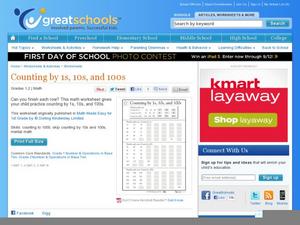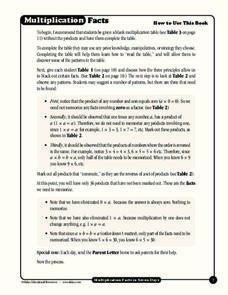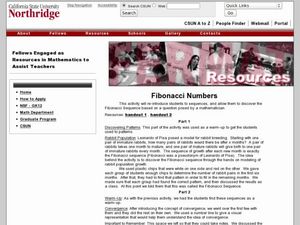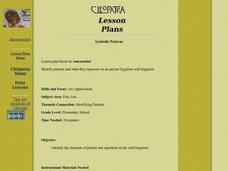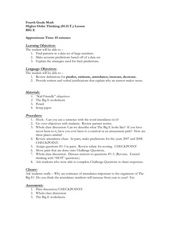Curated OER
Counting by 1s, 10s, and 100s
These sequences are missing numbers and require some skip counting to complete. Scholars finish rows of numbers first counting by 1s, then 10s, and finally 100s. Each has three given numbers to get them started, and they fill in five...
Curated OER
The Tango
Fourth graders explore the music of Buenos Aires as they hear and then dance the Tango. They practice basic Tango rhythm, learn to sing the song, "Any Turkey can Tango," then practice a few Tango-riffic dance steps with a partner. What a...
Alabama Learning Exchange
Introduction to Division
Examine how addition, subtraction, multiplication, and division relate to and are separate from each other. As they listen to the book, The Doorbell Rang, they demonstrate the math described in the story by cutting up paper cookies and...
LABScI
The Rutherford Atomic Model: Hidden Obstacles
Historically, scientists had to be creative to study subatomic structure. Scholars step into their minds to recreate the procedure Rutherford used to create his atomic model. Learners identify the creative efforts of early scientists...
Kelly's Kindergarten
August Daily Activities
You'll feel more than prepared for the start of the school year with this collection of daily activities for the month of August! From filling in numbers on a calendar or coloring patterns to solving addition and reading comprehension...
Mary Pope Osborne, Classroom Adventures Program
Mummies in the Morning Egyptian pyramids, hieroglyphics
Visit the Magic Treehouse and take your class on a trip through time with a reading of the children's book Mummies in the Morning. Using the story to spark an investigation into Egyptian culture, this literature unit engages...
National Energy Education Development Project
Introduction to Wind Energy
The U.S. produced enough wind energy in 2015 to power all of the homes in Alaska, California, Delaware, the District of Columbia, Hawaii, Idaho, Maine, Montana, Nebraska, New Hampshire, North Dakota, Rhode Island, South Dakota, and...
Curated OER
Dice Games
Games and activities are wonderful for igniting interest in nearly any topic. With a pair of dice, your class will practice their basic math and social skills at the same time. Learners battle it out to see who can roll only odds or only...
Intel
Starquest
Almost every ancient culture observed the stars and saw pictures in the patterns. Studying stars allowed them to guide travelers, determine when to plant crops, when to harvest food, and the stories surrounding the images include some of...
Didax
Multiplication Facts
Learning their multiplication facts is a big step in the education of young mathematicians. Help achieve this goal with the support of this collection of instructional materials.
Curated OER
Fibonacci Patterns
Learners solve problems using the Fibonacci Patterns. In this geometry lesson, students trackthe growing rate of a rabbit population. They collect the data and graph their results. They make predictions based on their results.
Alabama Learning Exchange
Find a Pattern Using Children's Literature
Sixth graders listen to Demi's, On Grain of Rice: A Mathematical Folktale. They use the problem solving strategy of finding a pattern to determine the number of rice Rani will receive after 30 days. They create a spreadsheet which...
Curated OER
Symbolic Patterns
Students identify patterns and what they represent on an ancient Egyptian wall fragment. Artists often repeat shapes, lines, and forms to create patterns. Several examples of repetition and pattern appear in this wall fragment.
Curated OER
Enjoying Millions- Working with Millions
In this working with millions worksheet, 4th graders look for patterns when working with millions, and use mental math to determine a number. They add and subtract numbers from a number in the millions before using a set of clues to...
Curated OER
Operations of Complex Numbers and Intro to DeMoivre's Theorem
Students solve problems with complex numbers. In this algebra lesson, students factor complex numbers and simplify equations using DeMoivre's Theorem. They add, subtract, multiply and divide using negative roots.
Curated OER
Iterating the Function over Real Numbers
Young scholars use a spreadsheet to find sequences of numbers. In this algebra lesson, students find the values for c of a quadratic written in standard form. They relate the behavior of the graph to the values of the equation.
IXL Learning
Small Times Table Reference Charts
Support young mathematicians on their journey to fluent multiplication with these handy reference tables. Small enough to fit in their pockets, these charts allow children to practice their multiplication facts anywhere they go.
Curated OER
Entry 1 Numeracy--Word Level (Phonics)
In this entry numeracy phonics worksheet, students on five separate pages first list the five vowels in the blanks provided and then list the vowel missing in five short words that follow on each page.
Curated OER
Title Balancing With Tidy Numbers
Students use math manipulatives (ice block sticks) to show the addition of two 2-digit numbers. They discuss short-cuts that might be used to make the problem easier. they apply the same principle for adding larger numbers, as well.
Curated OER
Hide and Seek
In this patterns worksheet, 3rd graders, working with a partner, look at 6 groups of numbers, one partner covers one group of numbers, the other partner writes down the numbers they remember and together they look for a pattern in each...
Curated OER
LET'S PARTY!
Students identify a number pattern and extend the number sequence. They make generalizations given a specific pattern and create, describe, and extend patterns. They create a table that describes a function rule for a single operation...
Curated OER
Higher Order Thinking (H.O.T.) Lesson - BIG E
Fourth graders work with patterns while using large numbers. In this patterning lesson, 4th graders go over the definitions of the words: predict, estimate, attendance, increase, and decrease. They complete worksheets in which they track...
Curated OER
Number Chart and Number Line
First graders research strategies for identifying numbers through 100. In this number recognition lesson, 1st graders make games, create puzzles,and fill in missing numbers to practice number identification.
Curated OER
Sieve of Eratosthenes
Students discover the Sieve of Erathosthenes. They explore a method to find all the prime numbers in a group of numbers. Using models, students practice divisibility rules while examining the difference between prime and composite numbers.


